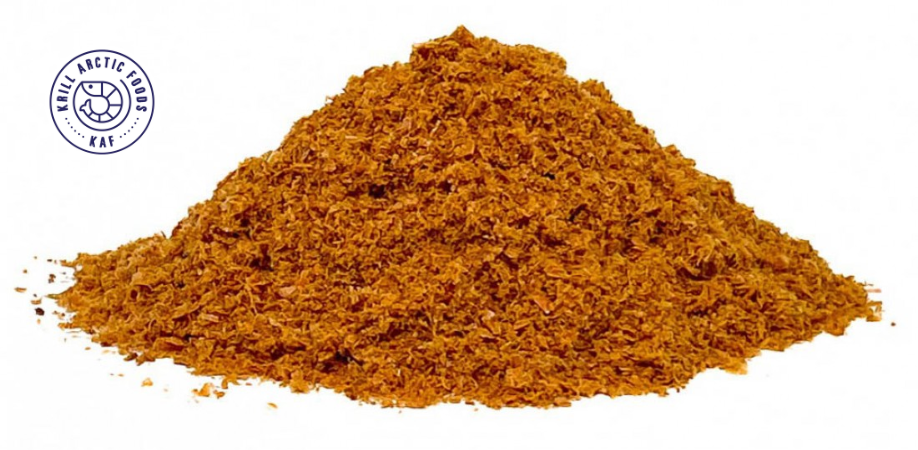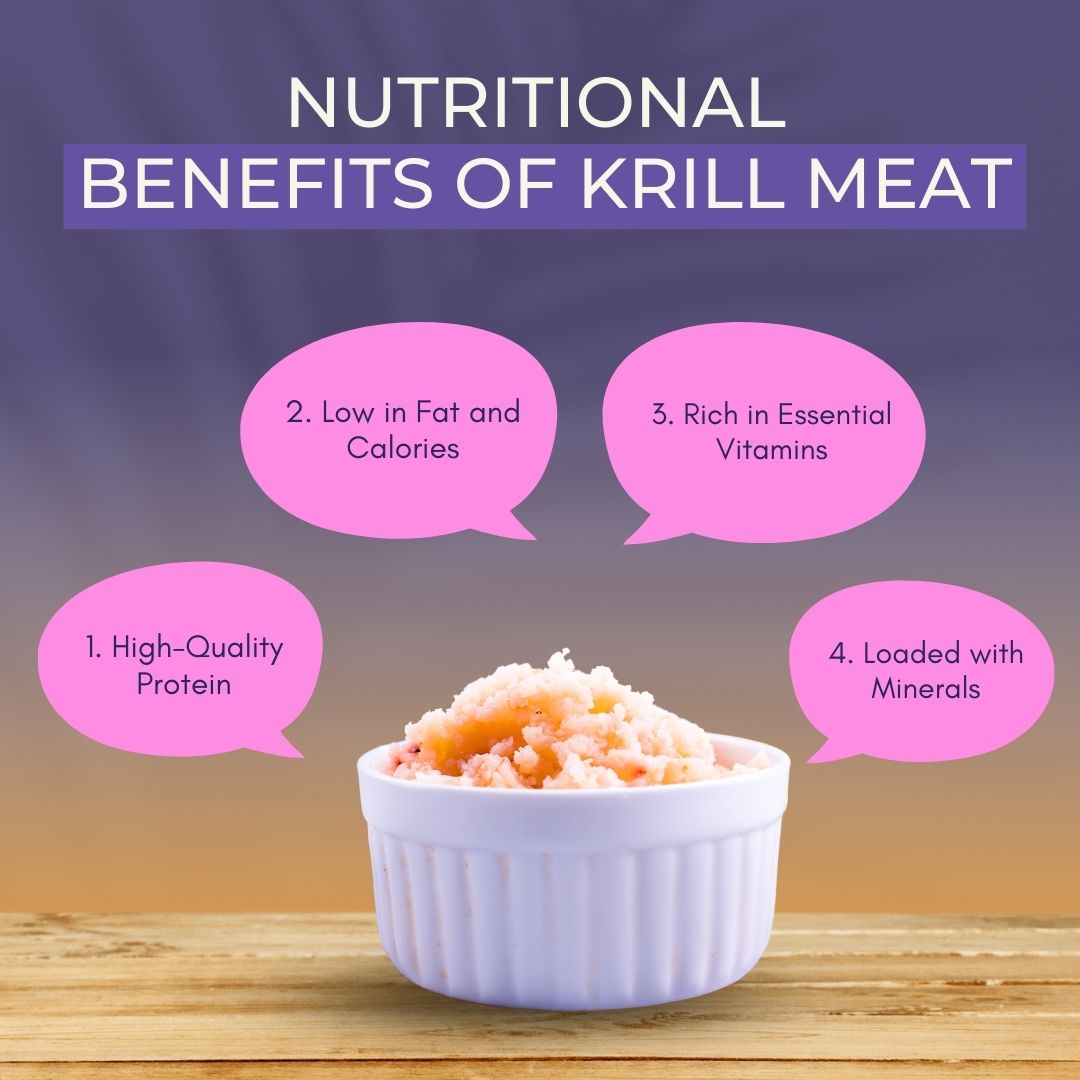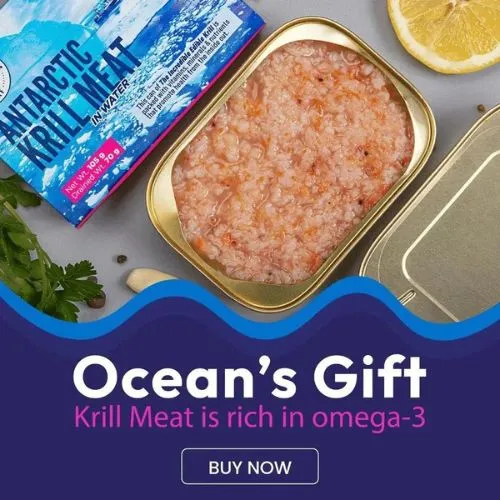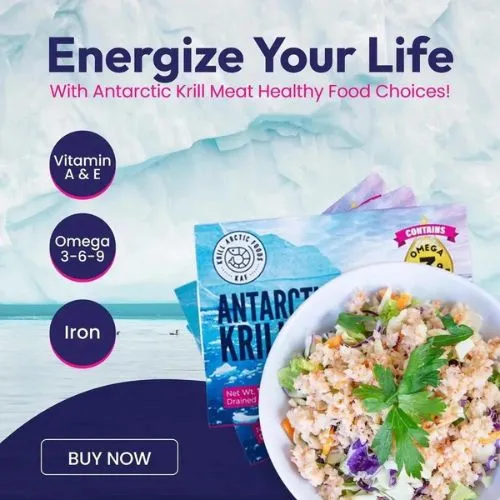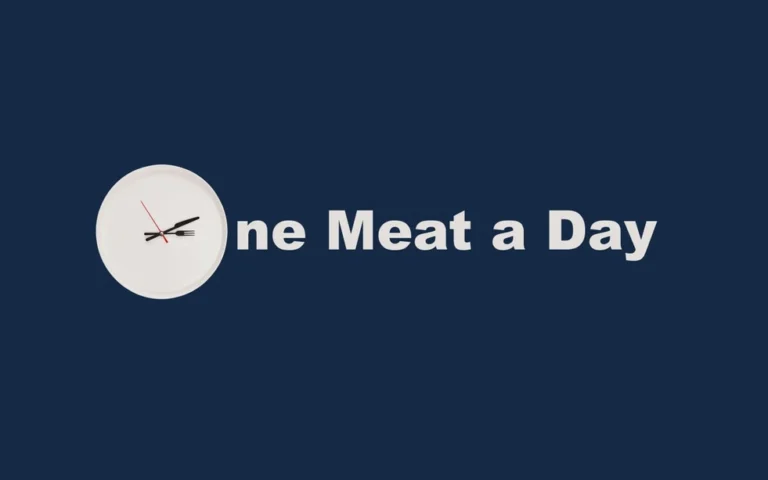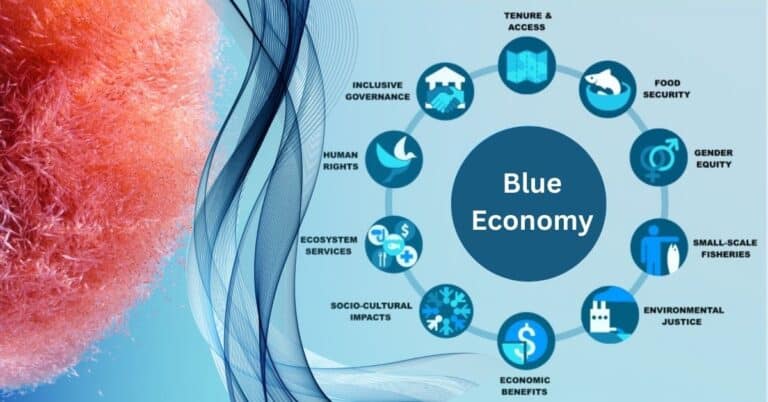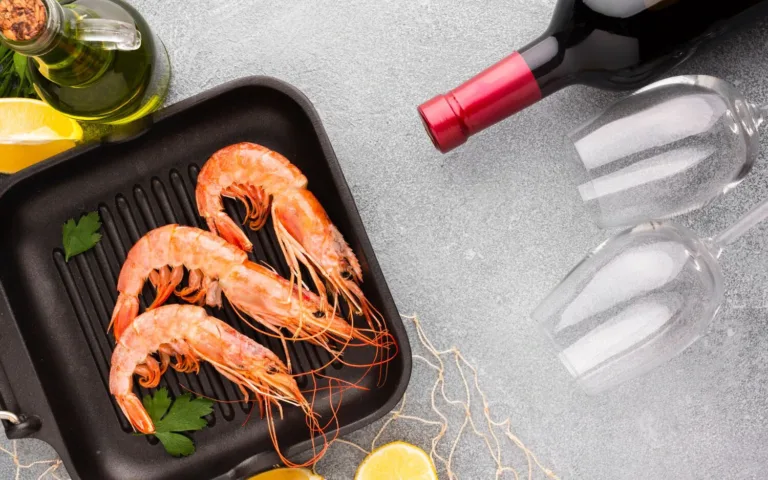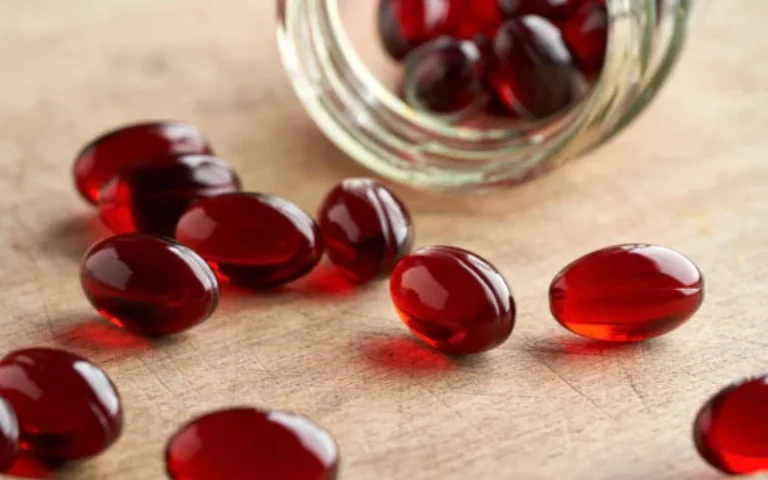In modern shrimp aquaculture, high-quality nutrition is essential for maximizing growth, survival rates, and overall health.
Krill meal, derived from Antarctic krill (Euphausia superba), has emerged as a superior feed ingredient due to its rich nutritional profile. It is packed with highly digestible protein, essential amino acids, omega-3 fatty acids (EPA and DHA), and natural astaxanthin an antioxidant that enhances shrimp pigmentation and immune function.
Additionally, krill meal is a powerful feed attractant, improving consumption rates and feed efficiency. As sustainability becomes a priority in aquaculture, krill meal is an eco-friendly alternative to traditional fishmeal-based diets. This article explores the benefits of incorporating krill meal into shrimp feed and its potential to enhance shrimp farming practices.
Krill Meal as a Game-Changing Feed Ingredient for Shrimp Aquaculture
Shrimp farming depends on more than just clean water and good management it starts with what they eat. A well-balanced diet fuels growth, strengthens immunity, and improves survival rates. Farmers are always looking for better feed ingredients to raise healthier shrimp, and krill meal is gaining attention as a powerful addition.
Sourced from Antarctic krill, this protein-rich ingredient does more than just provide nutrition. It boosts feed efficiency, enhances shrimp color, and supports overall health, making it a valuable alternative to traditional fishmeal. But why is krill meal such a game-changer? How does it help shrimp thrive while keeping aquaculture more sustainable?
This article breaks down everything you need to know about krill meal its nutritional benefits, impact on shrimp farming, and why it’s becoming a top choice for aquafeeds. Let’s dive in.
What Is Krill Meal and How Is It Produced?
Krill meal comes from Antarctic krill (Euphausia superba), tiny shrimp-like crustaceans that thrive in the icy waters of the Southern Ocean. These small creatures may not look impressive, but they pack a serious nutritional punch. Rich in protein, omega-3 fatty acids, and natural antioxidants, krill meal has become a go-to ingredient for aquaculture feed, especially for shrimp.
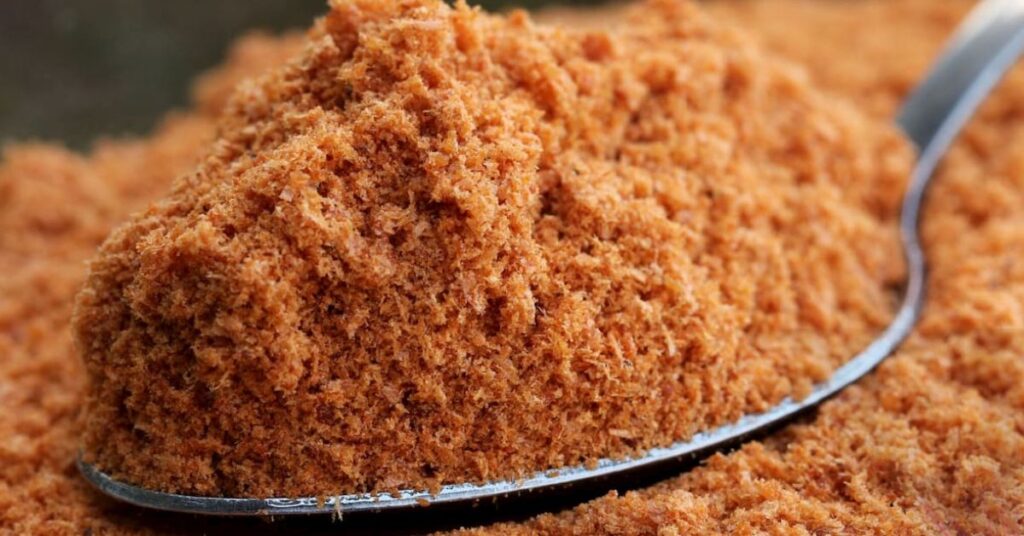
So, what makes krill meal different from traditional fishmeal?
While both are marine-based protein sources, krill meal offers unique advantages. It contains highly digestible protein, essential amino acids, and phospholipid-bound omega-3s, which shrimp absorb more efficiently than the triglyceride form found in fishmeal. Plus, krill naturally produces astaxanthin, a pigment that enhances shrimp color and protects cells from stress. The result? Healthier, more vibrant shrimp with better growth rates.
Nutritional Profile of Krill Meal: Why It’s Ideal for Shrimp Feed
Feeding shrimp the right nutrients isn’t just about keeping them alive it’s about helping them grow faster, stay healthier, and thrive under farming conditions. Krill meal stands out as a powerhouse ingredient, packed with protein, omega-3s, antioxidants, and bioactive compounds that shrimp need to perform their best. Let’s break it down.
High-Quality Protein and Essential Amino Acids
Shrimp need protein to grow, but not all protein sources are equal. Krill meal provides highly digestible protein, meaning shrimp can absorb and use it efficiently. This leads to better muscle growth, stronger shells, and higher survival rates.
What sets krill meal apart is its amino acid profile. It contains all the essential amino acids shrimp need, including lysine and methionine, which play key roles in tissue repair, enzyme function, and immune support. A well-balanced amino acid supply means healthier, more resilient shrimp that convert feed into growth more efficiently.
Rich Source of Omega-3 Fatty Acids (EPA & DHA)
Healthy fats aren’t just for humans shrimp benefit from them too. Krill meal is naturally rich in omega-3 fatty acids, particularly EPA and DHA, which are crucial for shrimp metabolism, immune defense, and stress resistance. These fatty acids help shrimp tolerate environmental changes, reducing the risk of disease and mortality. Unlike plant-based omega-3s, the ones in krill meal come in a form that shrimp can absorb easily. This means they get the full benefits without needing to process the fats further.
As a result, shrimp stay healthier and require fewer antibiotics, making krill meal a smart choice for sustainable aquaculture.
Natural Astaxanthin for Pigmentation and Antioxidant Benefits
Shrimp with bright, vibrant coloration are more appealing to buyers, and krill meal naturally enhances their pigment. That’s because it contains astaxanthin, a powerful carotenoid that gives shrimp their signature reddish-orange hue. But astaxanthin does more than improve appearance it’s also a potent antioxidant. It helps shrimp fight oxidative stress, boosts their immune system, and improves overall survival rates. Farmers who include krill meal in shrimp diets often see healthier stock and better market prices.
Bioactive Compounds That Improve Feed Efficiency
Krill meal isn’t just about protein and fats; it also contains bioactive compounds like chitin, phospholipids, and peptides that improve digestion and feed conversion. Phospholipid-bound omega-3s, for example, help shrimp absorb nutrients more efficiently, leading to faster growth and less feed waste. Another key component is chitin, found in krill shells. It supports gut health and acts as a prebiotic, encouraging the growth of beneficial bacteria in the digestive system. This leads to better nutrient absorption and a stronger immune response, reducing the need for medications and supplements.
Balanced Nutrition for Sustainable Growth
Krill meal provides a complete nutritional package that helps shrimp thrive without relying on synthetic additives. It delivers high-quality protein, essential fats, immune-boosting antioxidants, and digestion-enhancing compounds, all in a single ingredient.
So read on next, we’ll explore how krill meal impacts shrimp health, survival rates, and overall farm profitability.
The Impact of Krill Meal on Shrimp Health and Growth
The right feed can make all the difference in shrimp farming. Krill meal doesn’t just provide nutrients it actively improves shrimp health, growth, and survival. Farmers using krill meal report stronger shrimp, better feed efficiency, and fewer losses. Let’s look at five key ways it makes an impact.
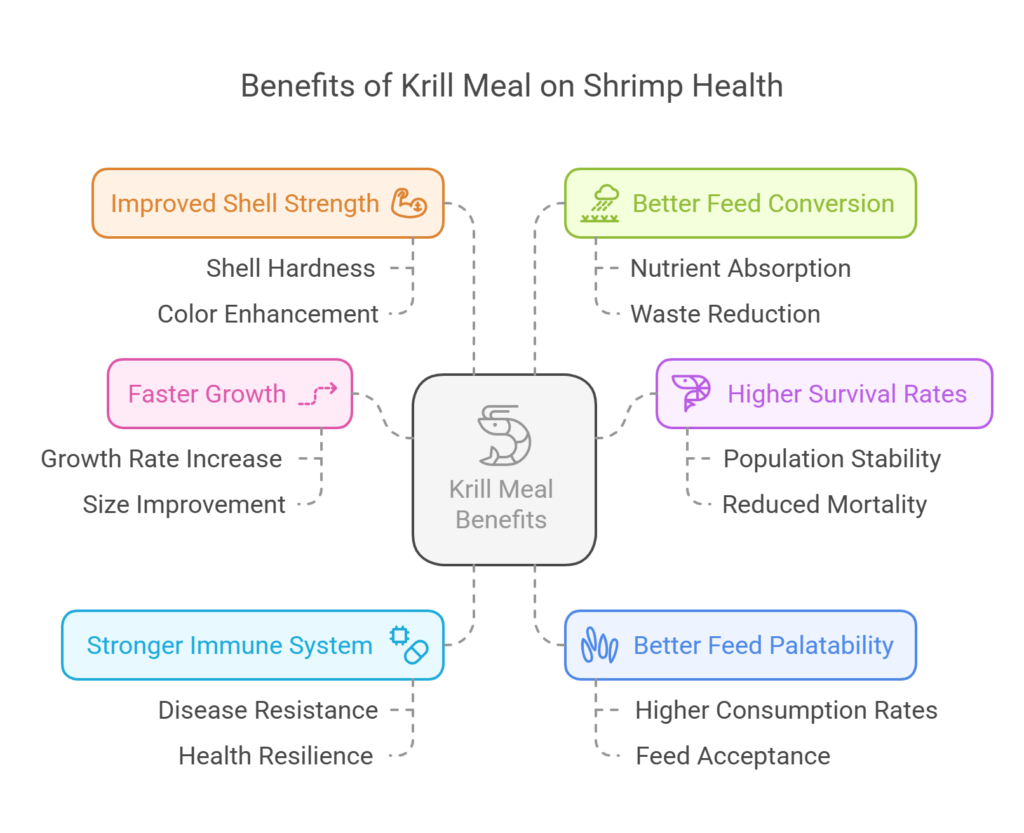
Faster Growth and Higher Survival Rates
Shrimp grow in stages, shedding their shells in a process called molting. The faster they molt and form new shells, the quicker they reach market size. Krill meal speeds up this process by supplying easily digestible protein and essential amino acids. Studies show that shrimp fed krill meal grow faster and have higher survival rates compared to those on standard fishmeal-based diets. Stronger shells and well-developed muscles make them more resilient, leading to lower mortality and higher yields.
Stronger Immune System and Disease Resistance
Shrimp are vulnerable to infections, especially in crowded farm conditions. Krill meal contains bioactive compounds that help strengthen their immune defenses. Omega-3 fatty acids reduce inflammation, while astaxanthin acts as a natural shield against oxidative stress. Even gut health gets a boost. The chitin in krill shells promotes beneficial bacteria in the digestive system, reducing harmful pathogens. Healthier shrimp means fewer disease outbreaks, less reliance on antibiotics, and more stable production.
Better Feed Palatability and Higher Consumption Rates
Ever noticed how some animals prefer certain foods over others?
Shrimp are the same way. Krill meal has natural attractants that make feed more appealing, leading to better intake and faster growth. A stronger feeding response means shrimp get the nutrients they need without wasted feed. Farmers benefit from lower feed costs and less pollution in the water since uneaten food won’t sink and decay.
Improved Shell Strength and Pigmentation
A weak shell is a shrimp’s biggest vulnerability. If it doesn’t harden properly after molting, the shrimp becomes easy prey for disease and stress. Krill meal provides the right balance of protein, minerals, and phospholipids to strengthen shells quickly.
And let’s talk about color. The natural astaxanthin in krill meal enhances pigmentation, giving shrimp the deep red-orange hue that buyers look for. A well-colored shrimp doesn’t just look healthier it sells for a higher price.
Better Feed Conversion and Sustainable Farming
Feed conversion ratio (FCR) measures how efficiently shrimp turn feed into growth. Lower FCR means less feed is needed to raise them, reducing costs and environmental impact. Krill meal’s superior digestibility helps shrimp absorb more nutrients, leading to better FCR and more sustainable farming.
Now here comes the good part krill meal not only benefits shrimp but also supports responsible aquaculture. With better growth, immunity, and feed efficiency, it’s a smart investment for both farmers and the environment. Let’s dive into its sustainability next.
Sustainability and Environmental Benefits of Using Krill Meal
Shrimp farming is expanding fast, but the search for sustainable feed ingredients is more urgent than ever. Traditional fishmeal production strains marine ecosystems, leading farmers to look for better alternatives. Krill Meal offers a solution that supports both aquaculture and ocean health.
Krill might be small, but they’re one of the most abundant species on the planet. Strict catch limits and responsible harvesting methods ensure their populations remain stable, protecting the whales, seals, and seabirds that rely on them. Unlike fishmeal, which often comes from overfished stocks, krill meal is sourced with sustainability in mind.
Feed waste is another challenge in aquaculture. Uneaten food sinks to the bottom, polluting the water and harming both farmed shrimp and marine life. Because krill meal is highly digestible, shrimp absorb more nutrients, leaving less waste behind. Cleaner water leads to healthier shrimp, lower mortality rates, and a reduced environmental footprint.
But there’s more krill meal also eases pressure on fish stocks. By replacing part of the fishmeal in shrimp diets, farmers can help protect wild fish populations while maintaining high-quality nutrition. It’s a smarter, more sustainable approach to aquaculture that benefits both producers and the planet.
Challenges and Considerations When Using Krill Meal in Shrimp Diets
Krill meal has a lot to offer, but like any feed ingredient, it comes with challenges. Before making the switch, shrimp farmers need to consider a few key factors. Let’s take a closer look.
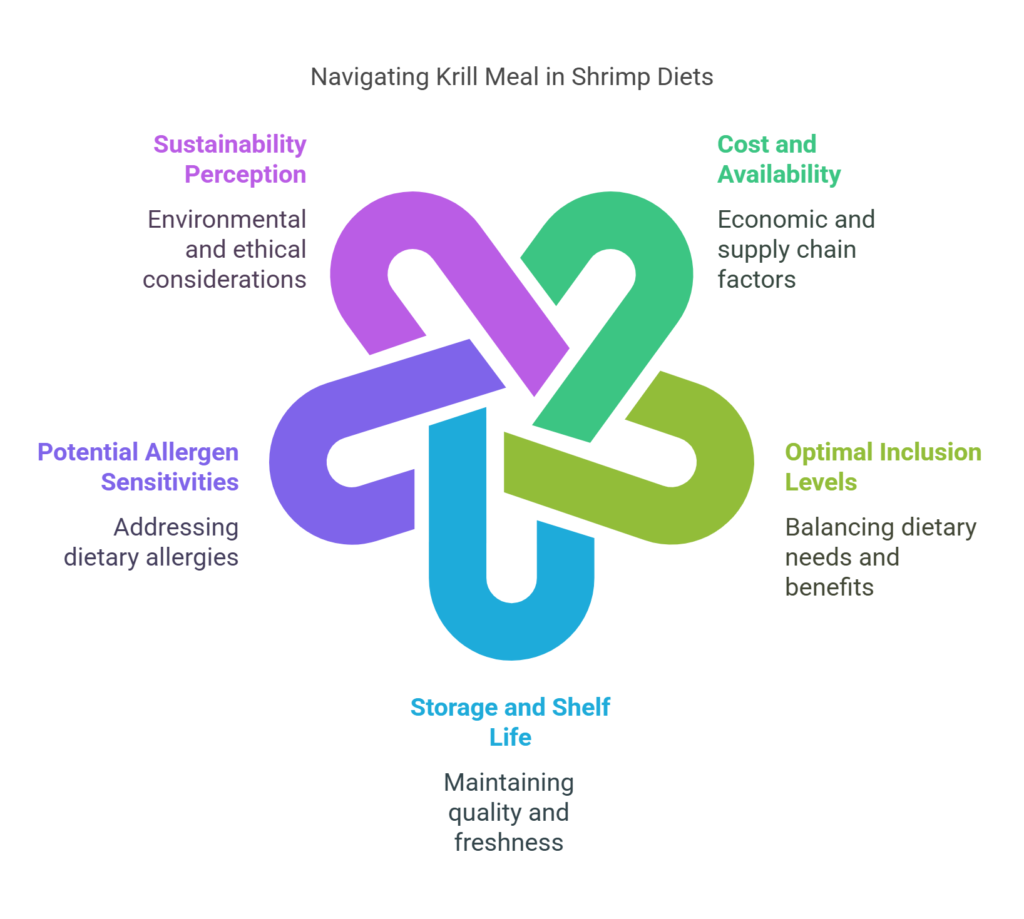
- Cost and Availability – Krill meal tends to be more expensive than traditional fishmeal due to controlled harvesting and processing methods. Supply can also fluctuate based on seasonal fishing limits and demand from other industries. While its benefits often justify the cost, farmers must balance quality with affordability.
- Optimal Inclusion Levels – More krill meals aren’t always better. Shrimp need a balanced diet, and excessive amounts can increase feed costs without added benefits. Research suggests that moderate inclusion levels (typically 5–15%) provide the best results in terms of growth, health, and feed efficiency.
- Storage and Shelf Life – Krill meal contains high levels of omega-3 fatty acids, which are prone to oxidation. If not stored properly, it can lose its nutritional value over time. Keeping it in a cool, dry place and using antioxidant preservatives can help maintain its quality.
- Potential Allergen Sensitivities – Some feed mills and farmers have raised concerns about krill meal triggering allergic reactions in workers handling it. While this doesn’t affect shrimp, it’s something to consider when implementing large-scale use in feed production.
- Sustainability Perception – While krill is harvested under strict regulations, some critics argue that increased demand could disrupt marine ecosystems. Farmers using krill meal should source from certified sustainable fisheries (such as MSC-certified suppliers) to ensure responsible use and maintain consumer trust.
Now here comes the good part despite these challenges, krill meal continues to prove its value in shrimp farming. In the next section, we’ll look at its future potential and how innovations are making it even more effective.
Future of Krill Meal in Shrimp Aquaculture
Krill meal has already made a big impact on shrimp farming, but its future looks even brighter. As the demand for sustainable, high-quality feed grows, krill meal is set to play a bigger role in shaping the industry. Let’s take a look at what’s ahead.
Researchers are constantly exploring ways to improve shrimp nutrition, and krill meal is at the center of many studies. Scientists are testing new formulations to maximize its benefits while reducing costs. Some feed producers are even combining krill meal with plant-based proteins to create more balanced and affordable.
More advances in krill harvesting and processing are making it easier to produce high-quality meals while protecting marine ecosystems. Companies are investing in better preservation techniques to extend shelf life and prevent nutrient loss. This means shrimp farmers can store and use krill meal more efficiently without worrying about oxidation.
Sustainability will continue to be a major focus. As more shrimp farms look for eco-friendly feed options, certified sustainable krill meal will gain popularity. Consumers are paying closer attention to where their seafood comes from, and responsible sourcing could become a selling point for farms that use krill-based diets.
Now here comes the good part shrimp farming isn’t slowing down, and neither is the demand for better feed solutions. With ongoing research, improved production methods, and a growing push for sustainability, krill meal is set to become an even bigger game-changer in aquaculture.
Conclusion
Shrimp farming is evolving, and better nutrition is at the heart of its success. Krill meal isn’t just another protein source it’s a nutrient-dense ingredient that improves shrimp health, boosts survival rates, and enhances overall farm efficiency. With its superior digestibility, omega-3 content, and natural astaxanthin, it supports growth while reducing waste and feed costs.
As the industry shifts toward more sustainable practices, krill meal is emerging as a key player in responsible aquaculture. Ongoing research is optimizing its use, and advances in harvesting ensure a steady, eco-friendly supply. Farms that incorporate krill meal aren’t just improving their yields they’re helping create a more sustainable seafood industry.
With its unmatched nutritional benefits and long-term viability, krill meal is shaping the future of shrimp farming. As demand for high-quality, environmentally responsible feed grows, it’s clear that krill meal isn’t just an option it’s an opportunity.

